
The Ultimate Guide to Kitchen Built-In Ovens: What You Need to Know
When it pertains to contemporary cooking areas, the built-in oven is more than simply a home appliance; it is a statement of design, effectiveness, and functionality. Built-in ovens are designed to incorporate effortlessly into cabinetry, supplying a smooth look that enhances the general style of the kitchen. This post checks out the numerous types, benefits, and factors to consider of kitchen built-in ovens, and supplies insights to assist you make an informed getting decision.
Tabulation
- What is a Built-In Oven?
- Types of Built-In Ovens
- 2.1 Single Ovens
- 2.2 Double Ovens
- 2.3 Steam Ovens
- 2.4 Wall Ovens
- Advantages of Built-In Ovens
- Secret Features to Look For
- Installation Considerations
- Regularly Asked Questions
- Conclusion
1. What is a Built-In Oven?
A built-in oven is an oven developed to be set up within kitchen cabinets rather than as a freestanding system. This style enables higher aesthetic flexibility while taking full advantage of readily available kitchen area. Built-in ovens been available in different sizes and setups, catering to varied culinary needs and kitchen designs.

2. Types of Built-In Ovens
Comprehending the different types of built-in ovens can help customers select the ideal one for their kitchen setups and cooking styles.
2.1 Single Ovens
Single ovens are compact and created to fit within standard cabinet widths. These ovens typically supply adequate area for daily cooking requirements, such as baking or roasting. They can be found in different electric or gas models and are often user-friendly with simple controls.
2.2 Double Ovens
For individuals who often host large gatherings or take pleasure in cooking multi-course meals, double ovens can be a lifesaver. These systems include two separate oven compartments and deal increased cooking capacity, permitting for synchronised baking or roasting at different temperatures.
2.3 Steam Ovens
Steam ovens make use of steam to prepare food, which assists retain moisture and nutrients. These ovens are progressively popular amongst health-conscious individuals and gourmet cooks. Steam ovens can be built-in along with traditional ovens for a flexible kitchen setup.
2.4 Wall Ovens
Wall ovens are developed to be installed within a wall rather than under countertops. They use convenient access and can be integrated with other wall-mounted kitchen appliances. Wall ovens might be offered as single or double systems.
3. Advantages of Built-In Ovens
Choosing for a built-in oven includes various advantages:
- Space Efficiency: Built-in ovens can be tucked into cabinets, freeing up important kitchen space.
- Visual Appeal: They offer a cleaner, more modern appearance than basic freestanding ovens.
- Range of Designs: Built-in ovens are readily available in numerous finishes, including sa4544cix stainless steel electric oven - buy Now!-steel, black, and white, enabling combination with various kitchen styles.
- Improved Functionality: Many built-in ovens come geared up with sophisticated functions such as self-cleaning modes, touch screens, and convection technology.
4. Key Features to Look For
When selecting a built-in oven, consider the following features to boost cooking performance:
- Temperature Range: A wider temperature range permits higher versatility in cooking various meals.
- Self-Cleaning Options: Look for designs that provide self-cleaning abilities to save time and effort on upkeep.
- Convection Cooking: Convection ovens flow air to prepare food equally and quickly.
- Wi-Fi Connectivity: Some modern-day built-in ovens featured Wi-Fi ability, enabling users to manage settings or pre-heat the oven from another location.
- Security Features: Check for features like automatic shut-off, kid locks, and cooling systems to guarantee maximum security.
5. Installation Considerations
Before acquiring a built-in oven, particular setup aspects need to be addressed:
- Size and Dimensions: Ensure the chosen oven fits the designated space. Procedure the height, width, and depth of the desired installation location.
- Ventilation: Gas ovens need sufficient ventilation to make sure safety. Seek advice from an expert if needed.
- Electrical Requirements: Check the electrical requirements of the selected system to make sure compatibility with existing outlets.
- Professional Installation: If you're not experienced in appliance installation, it might be sensible to seek professional support to guarantee proper fitting and compliance with regional codes.
6. Often Asked Questions
Q1: How do built-in ovens differ from freestanding ovens?A: Built-in ovens are installed in cabinets for a seamless look, while freestanding ovens stand alone and do not need built-in installation.
Q2: Can you install a built-in oven yourself?A: While some people with experience may choose to set up an oven themselves, it is normally advised to work with an expert to make sure electric or gas connections are securely installed. Q3: Are built-in ovens energy-efficient? A: Many built-in ovens include energy-saving technology and are typically more efficient compared to older designs. Always check energy rankings before acquiring. Q4: Do built-in ovens require unique maintenance?A: Regular maintenance includes keeping
the interior clean and examining for any wear and tear. Self-cleaning best fit their cooking design and design preferences. Whether a skilled chef or a home cook, the benefits of choosing a built-in oven are clear. By thinking about the details described in this guide, people can make educated decisions that will lead to years of cooking enjoyment. Extra Resources For more details on kitchen appliances, think about examining out the following resources: Consumer Reports: Product evaluations and purchasing guides. Energy Star: Energy-efficient appliance suggestions. Home Improvement Stores: Local specialists can offer additional insights and suggestions. Embarking on a kitchen remodelling or upgrade can be
designs can streamline this task significantly. Q5: What is the average life-span of a built-in oven?A: The typical lifespan of a built-in oven is typically in between 10 to 15 years, depending on use and maintenance practices. 7. Conclusion Buying a built-in oven can improve both the performance and looks of your kitchen. With numerous types and functions available, consumerscan choose models that










